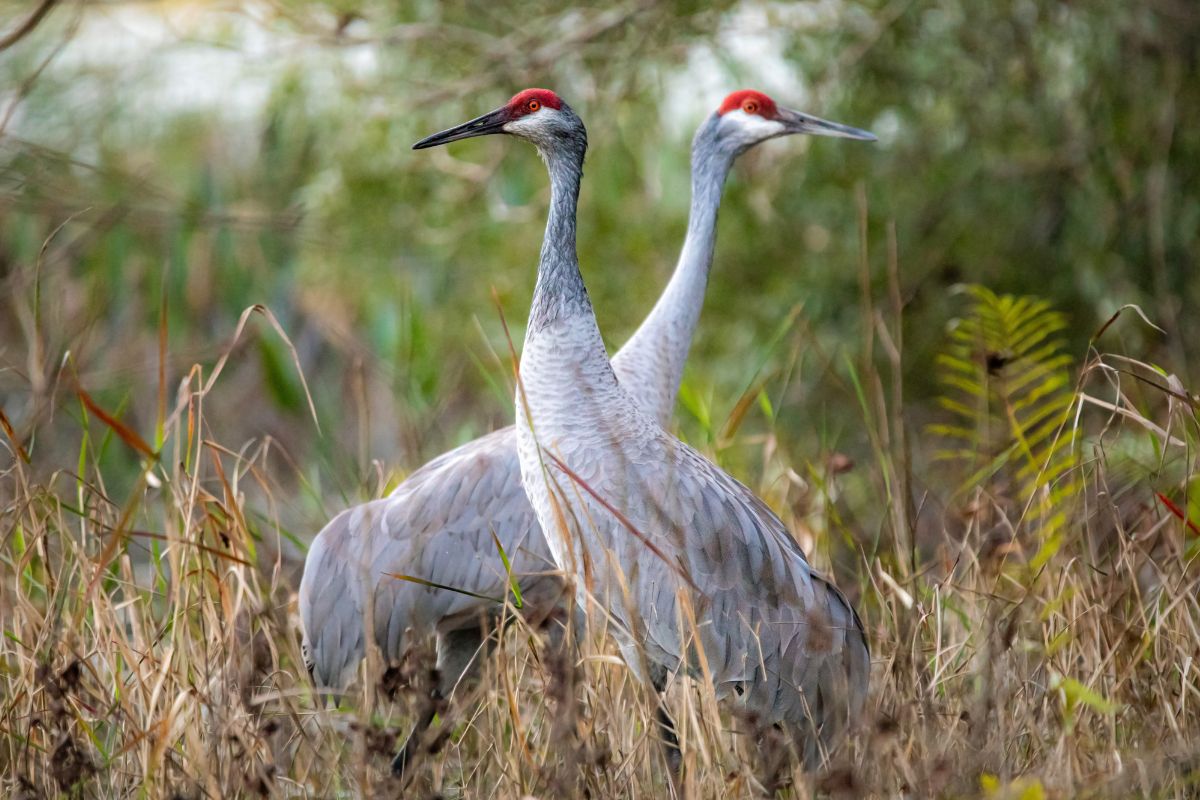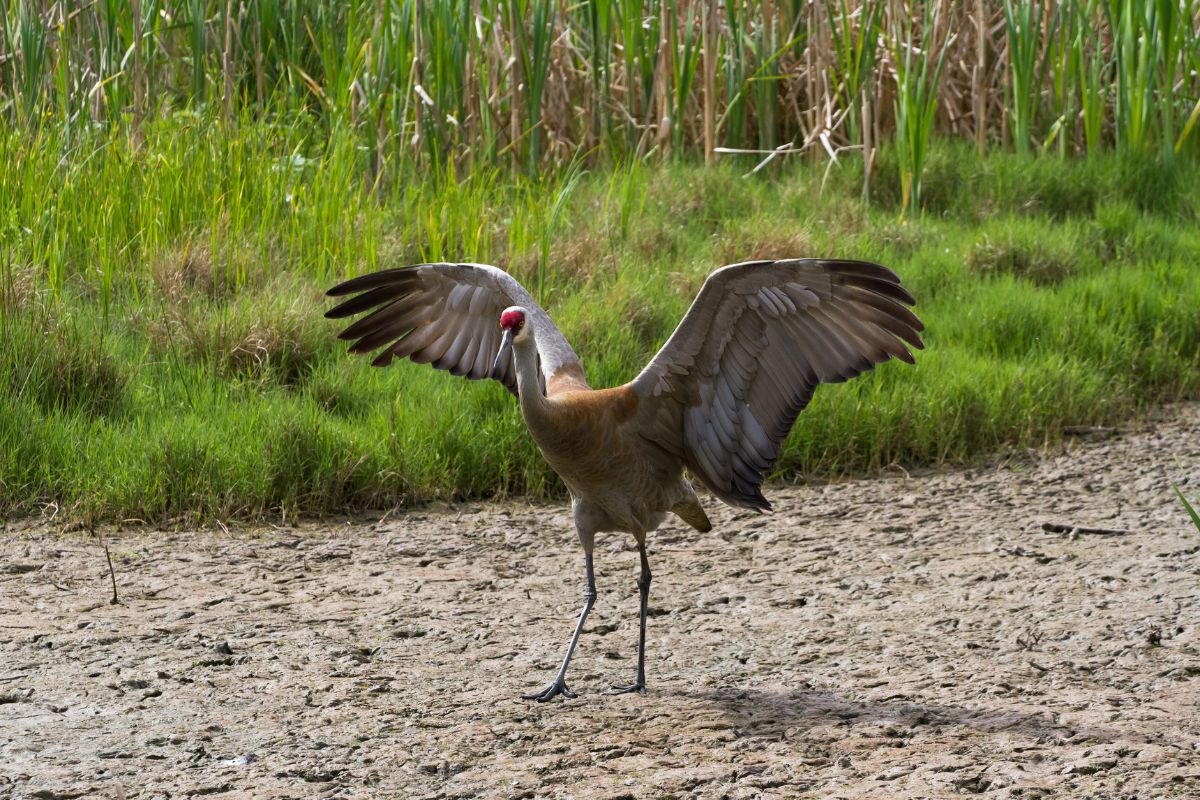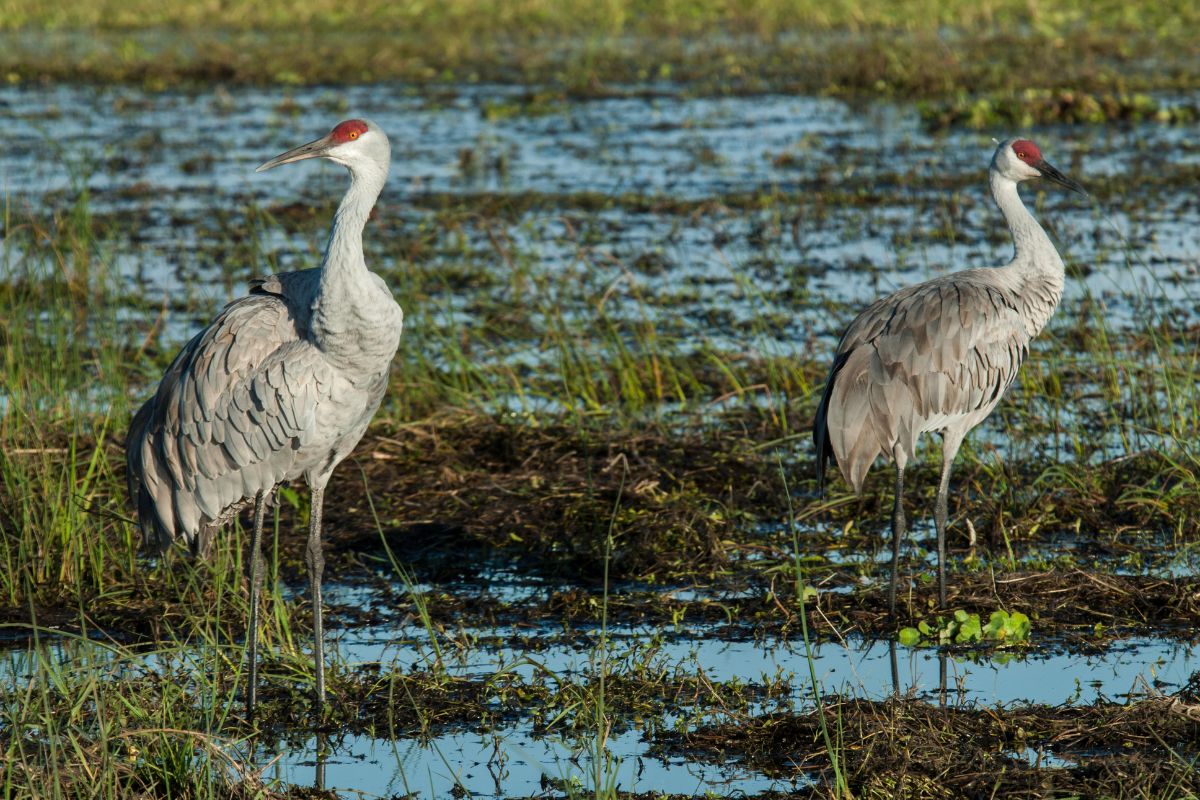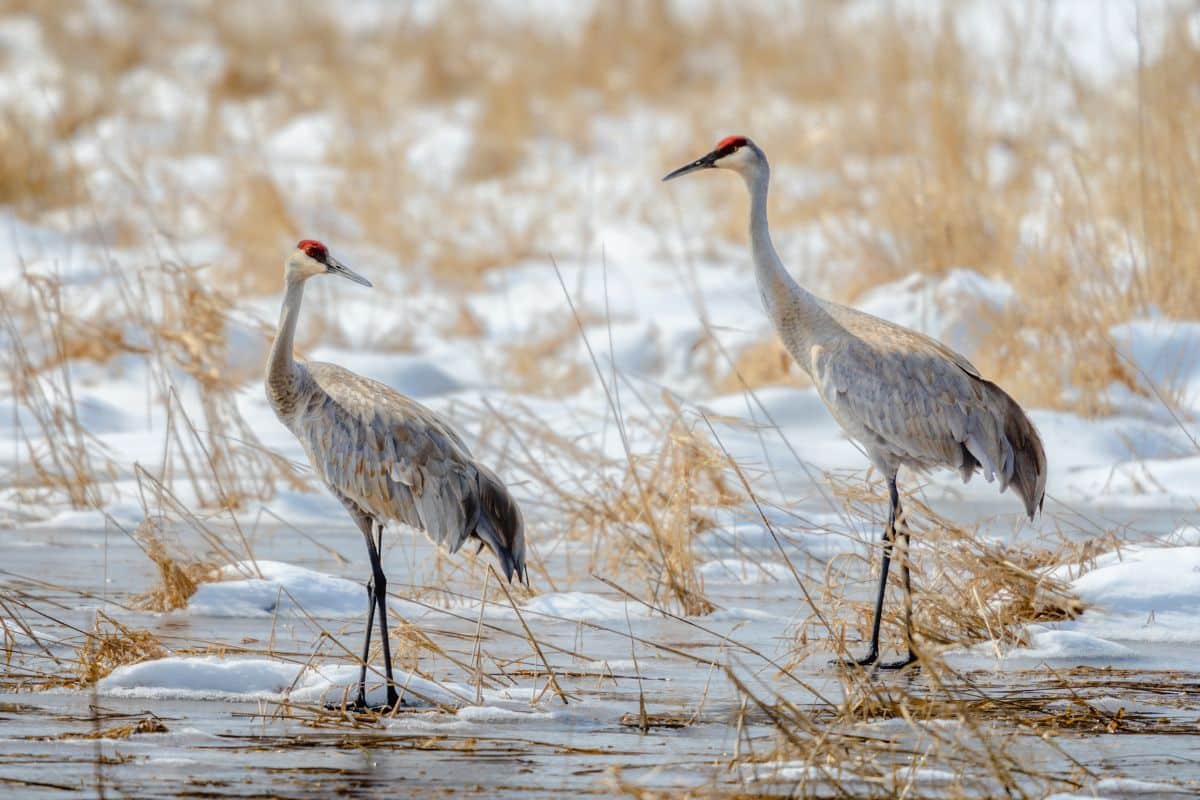Sandhill cranes constantly search the ground with their bills in marshes, open plains, crop fields, or mowed lawns. What exactly could these birds be looking for? What do sandhill cranes eat?

Sandhill cranes eat plants and small animals, making them omnivores. Their diet may include seeds, nuts, grains, roots, crops, fruits, snails, snakes, frogs, and lizards. These birds’ eating habits are seasonal, as they gravitate towards what’s available. Sandhill cranes’ diets will also vary due to their location.
This article discusses sandhill cranes’ eating habits. Herein are explanations of how much food these birds eat and why you shouldn’t feed them.
Contents
What Plants Do Sandhill Cranes Eat?
Although sandhill cranes eat just about everything, plants are their primary diet, making up about 73% of these birds’ total diet. Plants are widely and readily available hence the easiest option for them. Corn is the most common plant food among these birds. Sandhill cranes primarily consume lots of waste corn before migrating to supplement their diet.
A sandhill crane may be poking their bills in the ground, looking for seeds, roots, and berries. These birds also consume barley seeds, leaves, cottonseed, wheat, sorghum, nuts, fruits, cultivated crops, sunflower seeds, and acorns.
Sandhill cranes are opportunistic feeders, meaning they eat various plants in different locations. These birds eat corn, crops, seeds, tubers, wheat, barley, and rice in the uplands. However, while in wetlands, sandhill cranes eat tubers, flowers, and berries.
Interestingly, sandhill cranes don’t enjoy seedlings but planted seeds, which are easy to get off the ground. Therefore, keep these birds off your lawn if you’ve grown grains. You should also note that repellents don’t keep cranes from rummaging through your field. They won’t eat the treated seeds but look for other food types.
You can scare off sandhill cranes in your yard using scarecrows, but this is a temporary solution. With time, the cranes realize the scarecrow is harmless.
Using long aluminum foil strips taped to a string is an ideal way to keep sandhill cranes away from your garden. The strips will move around when the wind blows, scaring the cranes.
Do Sandhill Cranes Eat Animals?

When not sustained, sandhill cranes will supplement their diet with animals. These birds eat several animals, from snakes, insects, frogs, lizards, turtles, crayfish, eggs, and birds, to snails.
The animal types that sandhill cranes eat are also dependent on their location. In upland fields, they eat insects, earthworms, snakes, rodents, young birds, and eggs. Sandhill cranes eat fish, snails, crayfish, mussels, turtles, and frogs in wetlands.
What Do Sandhill Crane Chicks Eat?
Although baby sandhill cranes leave the nest a day after birth, they can’t feed themselves immediately, just like most younglings. Fledglings feed by pecking food from their mother’s bills for about two to three months after birth. After this period, sandhill crane chicks can find their food.
During spring, sandhill crane fledglings start by eating insects and gradually add other foods like small mammals and amphibians to their diet in summer. They may also begin to consume roots and tubers after a while.
The amount of food that sandhill cranes eat increases with time because of their high growth speed. Cranes grow to double their initial size two weeks after birth and nearly reach their parent’s size in two months. These birds start flying at three months.
How Much Food Do Sandhill Cranes Eat?
A single sandhill crane eats an average of four hundred corn kernels during spring. Bigger cranes might consume up to eight hundred corn kernels daily. A flock of sandhill cranes might consume 30-60% of planted seeds.
Sandhill cranes are large birds. The biggest weighs about fifteen pounds, and the smallest around seven to eleven pounds.
These birds require large amounts of food to sustain their body sizes. Moreover, cranes fly for about two hundred and fifty miles daily, which requires lots of energy.
How Do Sandhill Cranes Get Food?

Sandhill cranes easily get food as they can eat almost everything. These birds search for food with their bills down, rummaging through the ground for anything they can eat, from planted seeds to earthworms and insects.
Sandhill cranes use tactile senses and vision to locate specific types of food. These birds identify the yellow star grass from their pubescent blades. After recognizing them, cranes follow the blades with their bills up to their roots and pull them out. They then pound the plants, leaving the tubers for consumption.
Sandhill cranes identify false garlic and bugs using their tactile senses. They will dig into the soil for these foods even when there’s no evident clue. These birds stand in a rigid posture, and their bodies move with their heads when pounding hard foods like pine seeds.
When searching for insects, sandhill cranes move with their heads close to the vegetation or ground. These birds pause, curve their necks, and quickly catch the insects after identifying them.
Cranes search for big animals like frogs and moles with open beaks or bills. After capturing, the crane shakes and pounds its prey until it dies before consuming it.
Why Can’t Humans Feed Sandhill Cranes?
Although sandhill cranes are easily found in urban areas, i.e., airports and golf courses, you shouldn’t feed them. Feeding these birds, intentionally or accidentally, is hazardous for both the bird and the human. Below are reasons why you shouldn’t lure these birds with food.
- Cranes will lose their fear of people. Therefore, easily grab food from them and peck them.
- Luring cranes into your home with food makes them susceptible to predators like dogs.
- Feeding cranes from your car may cause them to destroy your windows as a defense mechanism against their reflection.
- Giving these birds one type of food, like corn, alters their diet or menu, which is pretty diverse.
- Cranes may get stuck in human garbage.
- Inviting sandhill cranes into your fields places them at risk of consuming pesticides present in some crops.
- Feeding cranes from your yard places them at risk of being hit when crossing the street.
Final Thoughts

Sandhill cranes aren’t picky eaters. These birds could eat about anything they come across. However, it would help if you didn’t try to feed them because doing so is hazardous to you and the birds.
Frequently Asked Questions
Here are answers to commonly asked questions about sandhill cranes and their diet.
Do sandhill cranes change diets seasonally?
Sandhill cranes change their diets seasonally. These birds are opportunists and will eat whatever’s available during that season. Sandhill cranes’ diets also vary depending on their location too.
What do sandhill cranes eat in their natural Habitat?
Sandhill cranes eat plants and animals in the wild. Some of their foods in the wild include insects, worms, birds, snakes, lizards, berries, and grains.
Are sandhill cranes hunters?
Sandhill cranes aren’t hunters. These birds search for food like small animals by picking them up from the ground. Sandhill cranes use their bills to get roots, tubers, and earthworms in the ground.
What lures sandhill cranes?
Sandhill cranes are attracted to areas near water, like marshes and open fields. You could also lure these birds into crop fields and large lawns.
Do sandhill cranes eat baby ducks?
Sandhill cranes can eat baby ducks. Although these birds primarily feed on fish and amphibians like frogs and turtles in the water, they may also eat small ducks.
